June 2017 62
Vicious Cyber-War Against Venezuela
Vicious Cyber-War Against Venezuela
By Manuel E. Yepe
The psychological warfare being waged by the oligarchic opposition in Venezuela –following the strategic and tactical objectives of US imperialism– has strong support in a well-organized Twitter operation that promotes protests from the Miami-based DolarToday platform. This is described in a research article published by the well-known specialist Erin Gallagher.
DolarToday is a US website based in Miami that, according to Wikipedia, “is more known for being an exchange rate reference to the Venezuelan bolivar” and “monitoring the Venezuelan economy.”
Currently, with no other reliable source other than the black market exchange rates, these rates are used by Reuters, CNBC, and several media news agencies and networks.
The Economist states in its defense that the rates calculated by DolarToday are “erratic”, but that they are “more realistic than the three official rates” released by the Venezuelan government. It maintains that it is not true that the rates published by DolarToday are manipulated in order to undercut the Venezuelan government.
The DolarToday website has been denounced by the Venezuelan State for setting a parallel dollar artificial price marker (black market). It has also been the target of a lawsuit by the Central Bank of Venezuela for falsifying the country’s exchange rates.
In 2013, President Maduro accused the website of “fueling an economic war against his government, and manipulating the exchange rate.”
“DolarToday is also promoting opposition protests in Venezuela. Its tweets are being boosted by automated accounts that exhibit repetitive, bot-like characteristics and are using a social media management tool called IFTTT (If This Then That) to automate their tweets”, says Erin Gallagher.
“What immediately caught my attention in the #TeamHDP hashtag data were the shared networks between the influencers (real persons of high credibility),” explained the specialist.
Trolls and bots carry out coordinated attacks to create false trends, congest or disrupt networks, and disseminate misinformation. Sometimes they succeed having a respected media –by neglect or mistake– disseminate their fake information and misleading headlines.
“Bots” are automated systems or programs –that can be run on home computers or on sophisticated servers—which use non-existent Twitter accounts to repeat a certain phrase hundreds or thousands of times. Thus they can turn those phrases into “trends”; that is to make them appear among the 10 or 20 topics that Twitter considers the subjects most discussed in recent hours.
Bot experts disguise themselves as “digital marketing companies”,create dozens or hundreds of fake Twitter accounts, and then use “bots” so that these accounts simultaneously tweet certain content, including headlines from news sites.
Because many journalists in the print media, radio and television use Twitter trends to determine what topics to deal with in their media, whoever dominates Twitter trends can get to determine the topics most talked about in the country’s media.
Gallagher says it is relatively easy to discover the use of these systems: when you enter a tag on Twitter and then click “Most Recent”, you will notice that there are hundreds or thousands of accounts tweeting exactly the same phrase.
This is not the first time robotic cyber actions have been observed in Venezuelan networks. Mexican researchers from the platform “LoQueSigue” used, in 2014, bots with the hashtag #PrayForVenezuela, which denounced “the violence, the repression and the supposed “censorship” of the protests in Venezuela,” which became a worldwide trend.
In addition, NoBotsPolitico of Spain documented fake accounts that supported the protests in Venezuela until June 2014, then remained silent for eight months, but went back to tweeting propaganda against Podemos in hashtags related to the 2015 elections in Spain.
Bloomberg published a feature on an investigation of March 2016 titled “How to Hack an Election” about the Colombian hacker Andrés Sepulveda, who worked with a team of hackers to manipulate information about the elections in Latin America. Sepulveda is currently serving 10 years in prison for crimes such as abusive access to computer networks, violation of personal data, espionage, and the use of malicious software during the 2014 election in Colombia.
It is not difficult to guess who controls the automated accounts that support #TeamHDP. The counterrevolution will someday have to answer for so much crime against the Venezuelan people.
June 26, 2017.
A CubaNews translation. Edited by Walter Lippmann.
Lack of labor discipline, a problem that needs solving

Lack of labor discipline, a problem that needs solving
Author: Lourdes Perez Navarro
January 10, 2009 0:40:08 CDT
A CubaNews translation.
Edited by Walter Lippmann.
A little over two years ago, the Resolution 188 of 2006, issued by the Minister of Labor and Social Security, came into effect. Consequently, institutions created or updated their internal disciplinary regulations. The aim was to strengthen labor discipline, educate the workers and deal with the lack of discipline and illegalities present in work places.
The draft [of this Resolution] was discussed and analyzed in meetings with workers before its approval, because it establishes rules and obligations at the workplace. Obligations include punctuality, meeting schedules, not leaving the workplace during working hours without permission of the supervisor, etc. It also states prohibitions like, not punching the card or signing the attendance record of another employee, and serious offenses, such as repeated absences, unjustified unpunctuality, and disregarding warnings and remonstrances.
According to Resolution 188, administrations are obliged to disclose and permanently explain to the workers the internal disciplinary regulations. Workers must obey regulations, or be subject to different disciplinary sanctions, depending on the gravity of the infraction.
It is known that lack of labor discipline slows production rates, erodes service quality and efficiency, and damages the country’s economy. It also dissatisfies the population. For example, if a machine operator doesn’t arrive on time, he interrupts or reduces that day’s production. If a lab technician is absent from work, a number of clinical trials can no longer be made.
These things are happening now. Specialists of the Ministry of Labor and Social Security monitored 2 042 companies and budgeted units during May-June 2008. The study showed that 60% of the workers did not comply with their working day.
They recorded 26 622 violations of labor discipline. Some of them were: late arrivals (46%), taking more than the allotted time for recess and eating (19%), working less than the stipulated working hours(13%), leaving before closing time(10% ) performing other unauthorized activities (5%), and leaving the workplace without proper authorization (4%).
Are a lot of financial and material resources needed to control and enforce discipline and efficient performance during the working day in each workplace? Or do we need more control, supervision and organization at the workplace?
Local administrations and directors are responsible for ongoing observation and control of how their workers comply with their obligations and abide by the rules established. Higher instances must be more demanding.
Why are internal disciplinary regulations put away in a drawer? On the contrary, they should be displayed on the workplace bulletin board, so all workers can see them. The Boards of Directors should periodically discuss the results of internal control checks.
Lack of labor discipline is not only personal. Certainly, those who violate discipline have names, and are liable to disciplinary actions that affect their pocket, their prestige or, in more serious cases, cost them their jobs.
But, this is not the only consequence. It damages the workers collective image, hinders completing economic plans, and affects the quality and efficiency of service. That is why labor discipline should be discussed in workers assemblies, at least once each quarter. This can not continue to be a problem.
How To Link Young People to Study and Work

A DEBATE ON HOW TO LINK YOUNG PEOPLE TO STUDY AND WORK
By Juan Morales Agüero
A CubaNews translation.
Edited by Walter Lippmann.
Social Workers considered this social problem in territorial evaluations and agreed that it has to be faced by all factors.
Las Tunas.-Nationwide, 2008 was the best year ever with regard to the reintegration and incorporation of young people to classrooms or workplaces. But, it has not yet reached all young people who neither do one, nor the other.
This statement was made by Enrique Gomez Cabezas, head of the social workers program in the country, during the provincial assembly of these professionals. The assembly analyzed the performance of this important program of the Revolution during 2008.
The most debated issue was, without doubt, young people who neither study nor work. Participants made a profound analysis and agreed that it needs a multi-factor approach. This is logical, because it is an issue that has a high priority today.
“We need to establish a link with the community, so that the different factors can keep us informed in a permanent and rapid way of the situation of the universe of their young people,” said Gomez Cabeza. He added that the work has to be personalized because there are no two cases alike. “Until we achieve this, we won’t have arrived at total results “, he said.
An aspect of the problem that received particular attention during the evaluation was the time period in which the identified cases must be dealt with. It is not enough to have the names of the young people in this situation. What is urgently needed is to work with them and resolve their situation.
Edgar Fernandez, from the municipality of Jesús Menéndez, took the floor to clarify that social workers have an enormous job before them regarding unemployed young people. He added that lots of creativity is needed to deal with it. And, that it depends on the links established with the family and the environment of the young person in question.
Cabeza Gomez took the floor again to remind participants that to have the healthy, just society we want to build, we can not have people that do not contribute anything to the country in terms of employment. He added that, in fact, many cases are very difficult and seemingly impossible to solve, but you can not dismiss anyone. We need to detect, identify and take care of them. “You have to be the social microscopes Fidel spoke about,” he said.
Yariri Torres, from the Amancio municipality, spoke about the usefulness of accompanying former prisoners throughout the process of getting jobs. She said former prisoners appreciate the presence of a social worker when they begin their new life in a workshop, a cooperative, or in any another job.
In a special intervention Deibis Garcia, provincial director of Labor, said that follow up is just as important as identifying and taking care of unemployed youths. If after the young person is studying or working, he doesn’t continue and gives up, then that defeat will be charged to our account.
A Probably Civil War in Israel
- English
- Español
A PROBABLE CIVIL WAR IN ISRAEL
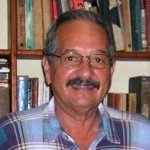
By Manuel E. Yepe
http://manuelyepe.wordpress.com/
Exclusive for daily POR ESTO! of Mérida, México.
A CubaNews translation.
Edited by Walter Lippmann.
Is Israel on the verge of civil war, as a growing number of Middle East commentators suggest, with its Jewish population deeply divided over the future of the occupation of Palestinian soil?
Such is the question asked by Jonathan Cook, British writer and journalist based in Nazareth, a specialist on Middle East issues who writes for The Guardian, Al Jazeera and other media, who attempted to answer it in a recent article.
Cook wrote that on one side is a new peace movement, Decision at 50, stuffed with former political and security leaders. Ehud Barak, a previous prime minister who appears to be seeking a political comeback, may yet emerge as its figurehead.
The group has demanded the government hold a referendum next year – the half-centenary of Israel’s occupation, which began in 1967 – on whether it is time to leave the occupied territories. Its own polling shows a narrow majority ready to concede a Palestinian state.
On the other is Benjamin Netanyahu, in power for seven years with the most right-wing government in Israel’s history. Recently he posted a video on social networks criticizing those who want to end the occupation.
Cook wrote that whatever its proponents imply, the Decision at 50 referendum is about neither peace nor the Palestinians’ best interests. Its assumption is that yet again the Israeli public should determine unilaterally the Palestinians’ fate.
An Israeli consensus believes Gaza has been free of occupation since the settlers were pulled out in 2005, despite the fact that Israel still surrounds most of the coastal strip with soldiers, patrols its air space with drones and denies access to the sea.
The same unyielding, deluded Israeli consensus has declared East Jerusalem, the expected capital of a Palestinian state, as instead part of Israel’s “eternal capital”.
But the problem runs deeper still. When the new campaign proudly cites new figures showing that 58 per cent support “two States for two nations”, it glosses over what most Israelis think such statehood would entail for the Palestinians.
So what do Israelis think a Palestinian state should look like? Previous surveys have been clear. It would not include Jerusalem or control its borders. It would be territorially carved up to preserve the “settlement blocs”, which would be annexed to Israel. And most certainly it would be “demilitarized” – without an army or air force. In other words, Palestinians would lack sovereignty.
Such a state exists only in the imagination of the Israeli public. A Palestinian state on these terms would simply be an extension of the Gaza model to the West Bank.
Nonetheless, the idea of a civil war is gaining ground. Tamir Pardo, the recently departed head of Israel’s spy agency MOSSAD, warned before his death that Israel was on the brink of tearing itself apart through “internal divisions”. He rated this a bigger danger than any of the existential threats posited by Mr. Netanyahu, such as Iran’s supposed nuclear bomb.
But the truth is that there is very little ideologically separating most Israeli Jews. All but a tiny minority wish to see the Palestinians continue as a subjugated people. For the great majority, a Palestinian state means nothing more than a makeover of the occupation, penning up the Palestinians in slightly more humane conditions.
According to Cook, Israeli moderates have had to confront the painful reality that their country is not the enlightened outpost in the Middle East they had imagined. Those who cannot stomach such a view will have to stop equivocating and take sides.
They can leave, as some are already doing, or stay and fight – not for a bogus referendum that solves nothing, but to demand dignity and freedom for the Palestinian people, advises Jonathan Cook.
September 22, 2016.
Cuban Reggaeton or… It’s All Peachy
Cachivache Media
April 7, 2017
Cuban Reggaeton or… It’s All Peachy
A CubaNews translation.
Edited by Walter Lippmann.
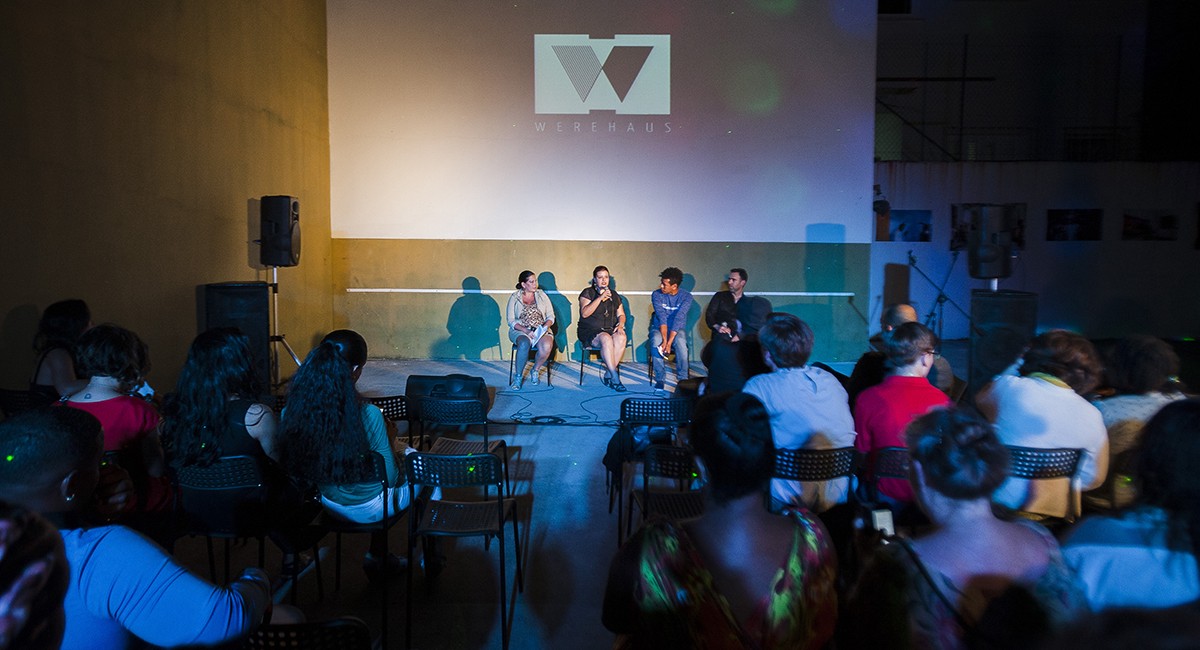
Panelists begin the debate after watching documentary “Reggaeton Revolution: Cuba in the Digital Age”. From left to right: The Goddess (Dianelis Alfonso Cartaya), reggaeton performer; Carmen Souto musicologist with Casa de las Américas; Marcos Junco, independent producer; and Marcos Juárez, director of the Latin music department of US Digital Music Producing Company Pandora. Photo: Fernando Medina / Cachivache Media.
By Maite López Pino
Cuban-American filmmaker Lisette Poole recently presented her documentary “Reggaeton Revolution: Cuba in the Digital Age” at the Royal Norwegian Embassy in Havana and the credits were still running when the debate began. In almost twenty minutes, Poole introduces everything: how the alternative recording houses operate; the production of this genre; the vital importance of “El Paquete” [The package] for its dissemination … the lifestyle of representatives of this genre; and the business concept that has been the cornerstone of this underground industry.
But she doesn’t go beyond that: an introduction. After seeing the documentary, it would seem that being a Cuban reggaeton performer is the quintessence of success as an artist in Cuba. Many of us remained waiting for the turning point where it would talk about why it is a censored genre in the Cuban mass media. Neither was there time to criticize the way it presents women as barely more than objects, or the patriarchal hegemony and gender violence that abound in the audiovisual products of this artistic expression.
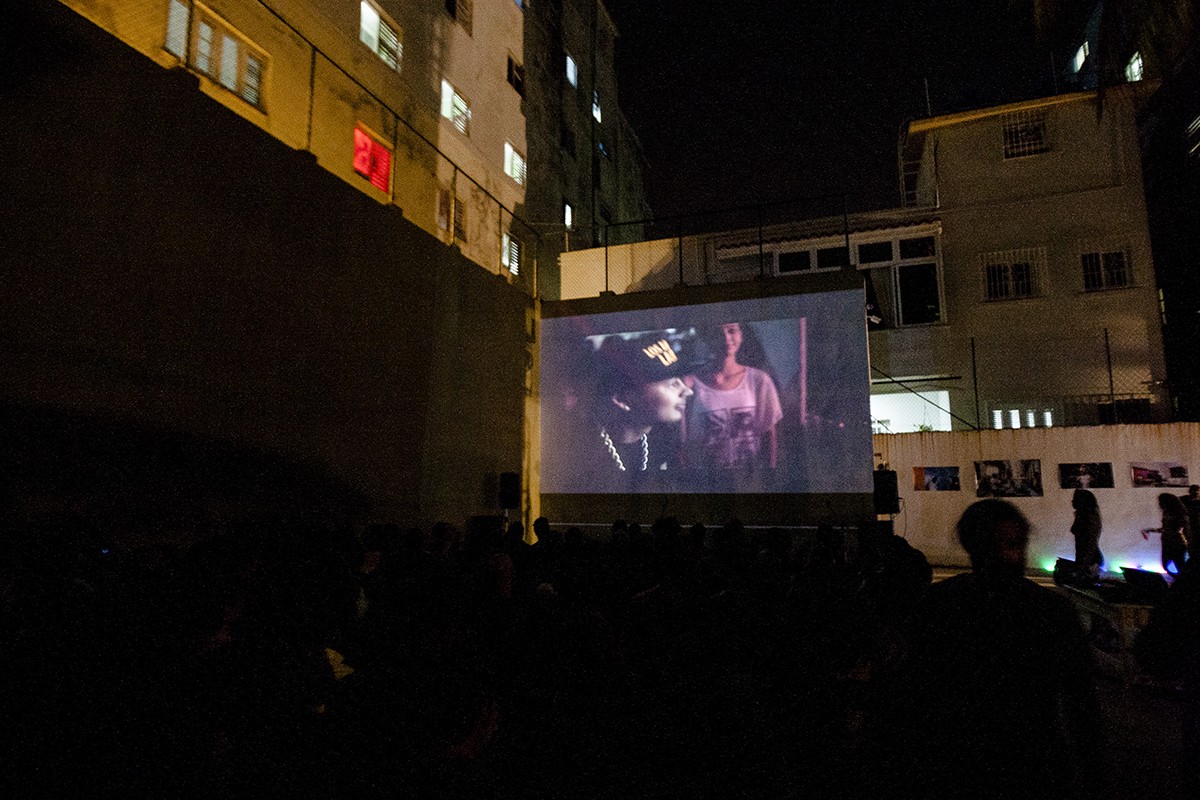
Premier of the documentary “Reggaeton Revolution: Cuba in the Digital Age”, by Lisette Poole. Photo: Fernando Medina / Cachivache Media.
Lisette Poole’s images and the documentary glorify reggaeton, throwing much light on its spectacular dimensions and leaving the elements that justify its censorship in the shadow.
The premiere was planned for two moments: the showing of the documentary that would be followed by a discussion between a group of panelists: The Goddess (Dianelis Alfonso Cartaya), performer of Cuban reggaetón; Carmen Souto, musicologist with Casa de Las Americas, Marcos Junco, independent producer, and Marcos Juárez, director of the Latin Music Department at the US Digital Music Production Company “Pandora”.
Producer Marcos Junco commented on his firsthand experiences witnessing “the turning point of rap towards reggaeton, and how the boom of independent studios began. All artists left the official studios and went into their rooms with a computer and a microphone to do wonders.
“In independent studies there is a person behind a computer playing many roles at the same time: making music, recording it, adding its voice, and even going out in the streets to promote the work done –trying to get it played on the radio, on TV, etc.–“
Carmen Souto, a musicologist with Casa de las Américas, analyzed the particular rhythmic and generic elements that make Cuban reggaeton so striking: “It is fusion music with a strong influence of timba and rumba. This makes it extremely attractive and generates a world special interest on the reggaeton that is made in Cuba.
Regarding censorship, the musicologist said that “when an institution represses a certain genre, it makes it visibl; because everyone feels the need to consume what is being forbidden.”
“Censorship was frequently mentioned in the documentary; I think it was one of the reasons they made this communication product: the fact that despite being a genre highly censored by the media, it is still very popular inside and outside Cuba, but mainly inside.”

Premier of documentary “Reggaetón Revolution: Cuba in the Digital Age”, by Lisette Poole. Photo: Fernando Medina / Cachivache Media.
Women and Reggaeton
It may seem that the role of women in Cuban reggaeton would be that of –paraphrasing [Argentinean comic strip artist Kino’s character] Mafalda– a rag … in particular a tiny bikini.
Reggaeton performer known as The Goddess spoke about women and their representation in this cultural expression: “Starting from the idea that we live in a society ruled by patriarchal precepts, reggaeton is also a gender dominated by men; it has been so from the beginning, and the participation of women in these spaces is very difficult”.
Danilo de la Rosa, activist of “Súmate”, the campaign for non-violence against women and girls, was among the audience present at the premiere of the documentary. He drew attention to phenomena that are seen in Cuban musical videoclips, where “men take it on women and women take it on men, and thus tend to create ghetto-like divisions”.
“Often, artists do not realize that they harm the public by symbolically reproducing within the media the violence that is exerted on women and girls. In certain videoclips they are being used as a sex objects or worthless things. This is not only the artists’ fault, but I believe that they should approach the campaigns for non-violence that are implemented in Cuba,” de la Rosa said.
He also asked the panelists how they work on the issue of gender equality in commercial communication products that promote reggaeton. Producer Marcos Junco said that it should be officials from the media who talk about the censorship of the lyrics in Spanish of reggaetón, and how, however, “the lyrics in other languages, such as those in rap , that are much more violent, are played on national radio and television channels. It is necessary to do more than a campaign to end gender discrimination. “
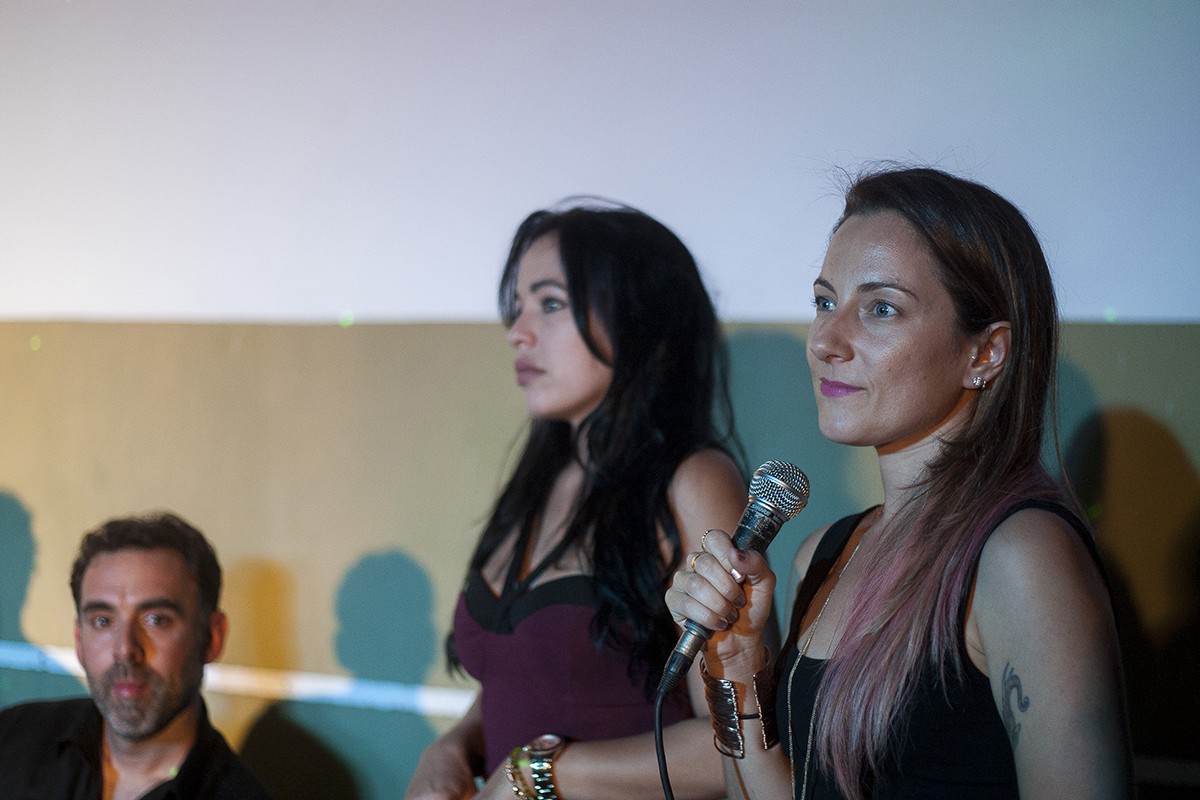
On the right, Lisette Poole, director of the documentary “Reggaeton Revolution: Cuba in the Digital Age”. Photo: Fernando Medina Fernández / Cachivache Media.
Those who see the documentary “Reggaeton Revolution: Cuba in the Digital Age” could infer that in Cuba, in matters of reggaeton “everything is peachy” –as is popularly said by many performers of this genre. However, beyond the usefulness or virtue of the material, more documentaries are needed to deepen on the question of the success of the music industry of underground urban genres in Cuba bis a bis the debacle of the official national system of musical production. Likewise, it is also urgent to discuss more about the relationship between this type of urban music and the media, as well as to analyze in detail the current censorship codes, and the coherence (or lack of it) of the Cuban cultural policies concerning reggaeton.
And this is so, because everything is not “peachy” when “El Paquete” –avidly awaited by much of the Cuban public in every corner of the country– delivers videos, photographs, songs and other elements that reinforce a questionable “artistic” concept in terms of aesthetics, quality and values.
USA TODAY announces Cuban coffee will reach the United States through a third party
- English
- Español

USA TODAY announces Cuban coffee will reach the United States through a third party
June 20, 2016
A Google translation. Revised by Walter Lippmann.

Cuban coffee picker in the eastern province of Santiago de Cuba. Photo: AFP
The next phase of change in Cuba’s relations with the United States will come in the form of coffee.
The Swiss company Nespresso, Nestle SA group, announced Monday that Cuban coffee will be sold in the US as of the end of this year. The long-banned coffee (as a result of the blockade), will be sold in a limited edition called Cafecito de Cuba, in stores, online and telephone trading.
Guillaume Le Cunff, President of Nespresso USA, said it is good to be the first company to provide Cuban coffee to the US market. He noted that Nespresso is very interested in developing a long-term agreement to ensure an adequate supply of Cuban coffee to US customers and improve the living conditions of the Cuban producers.
“We are not thinking of a short-term outcome,” said Le Cunff on Sunday. “This is the point nicial an initiative long term. We are very optimistic to manage and build the project. We want consumers in the US can experience this amazing coffee and enjoy them now and in the years to come. “
Nespresso it allied with TechnoServe, a nonprofit organization based in Washington, assisting coffee growers in Colombia. South Sudan, Kenya and Ethiopia. David Browning, vice president for strategic initiatives TechnoServe, recently visited Cuba to meet with government officials and visit the small farm where the Cuban coffee grows.
Most of the agricultural land in Cuba are managed by cooperatives of small private farmers. They sell their products to the government, which distributes on the island or export around the world. Nespresso begin their experiment buying Cuban coffee beans to European importers, toasting them, then packaging it and selling it in the United States.
Browning said the two companies discussed the new regulations approved by the US government and saw the opening they needed. “It was necessary that lawyers would ensure us that was totally understandable what the US government was trying. Everything was very clear, “he said.
According to USA Today, the next phase for Nespresso and TehcnoServe will help Cubans farmers improve their production process, helping get new agricultural equipment for harvesting plantation, something not clear how they would be implemented.
In a dispatch today, Reuters explains that in April, the US State Department added to coffee and other products to its list of eligible Cuban imports produced by independent producers.
The regulatory change made it easier Nespresso began sales in the United States of Cafecito de Cuba -a premium roasted espresso in their cafeteras- during this fall.
Cuba produces around 100,000 60-kg bags Arabica year, according to the International Coffee Organization. Although this volume is about five times the annual output of Jamaica, it is just a fraction of the 13.5 million bags waiting Colombia, the world’s largest producer of high quality Arabic washing, for this year.
(With information from Reuters and USA Today)
Cuba and exporters of products such as coffee can not yet directly access the US market. In a statement last May 5, the National Association of Small Farmers declared:
On April 22, the State Department announced the decision to include coffee in the list of Cuban products produced by the non-state sector, which would be imported into that country. With this action continuity to a measure adopted by the government of the United States in February 2015, allowing very limited Cuban exports, which excluded all goods and services produced by state enterprises was given.
He did not say the State Department is that the fact of having deprived unilaterally to Cuba – after decreed the lock- treatment of most favored nation, which rightfully ours as State Founder of the World Trade Organization, any product Cuban to be exported to the United States has to pay higher customs tariffs, which makes it practically impossible to import into that country.
It also ignores the Agrarian Reform Law, enacted after the triumph of the Revolution in 1959, did own the land more than 200,000 peasant families, and that the Cuban State has implemented since a program for productive, economic development and social peasantry of our country and ensured the production assistance, access to credit, secure market for their products and other social benefits.
No one can think that a small farmer can export directly to the United States. To make this possible must participate Cuban foreign trade enterprises and financial transactions have to occur in dollars, which so far have not been able to realize.
We are aware that the objective of these measures is to influence the Cuban peasantry and separate it from our state.
[…]
If the government of the United States really wants to contribute to the welfare of Cubans, what it has to do is definitely lift the economic, commercial and financial blockade imposed for more than 50 years, which is the main obstacle to the development of Cuba .

Café cubano llegará a Estados Unidos a través de un tercero, anuncia USA Today
20 junio 2016
Español
Mariana Hernandez, THE RAG interview, 1971
THE RAG INTERVIEWS MARIANA HERNANDEZ
February 22, 1971
MARIANA HERNANDEZ, interviewed by THE RAG, Austin, Texas,
Mariana Hernandez is the Socialist Party’s candidate for Travis LaRue’s job- mayor of Austin.
By printing this interview, The Rag does not mean to take sides in the upcoming election. But we would like to point out that almost any change would be an improvement.
The interview was taped on the spur of the moment at the Abortion Conference, where the Socialist candidates were promising to work for free abortions on demand if elected. The candidate’s willingness to speak into a somewhat hostile reporter’s tape recorder without advance notice was remarkable in the context of Texas politics.
RAGT: How do you propose to change the abortion laws from the City Council?
MH: Well, what we intend to do first of all is help build the Women’s Liberation movement. We will involve ourselves in all the building aspects of it and in that way involve a larger number of people. What we will do at the City| Council is also have it at a time when more women are able to come to meetings and express their views as to what the City Council ought to be| doing. That is, we won’t have them at 9 o’clock in the morning when most people can’t come. There are working women who can’t present their views because they’re working… RAG: Wouldn’t you say that most men can’t participate at that time either, so it’s a bit unfair to all citizens?
MH: That’s true. So we would have it at a time when all citizens could participate.
RAG: How do you see. your chances for winning?
MH: Well, what we see is that if we get the publicity, if we get out and are able to take our demands to the people, they’re going to support us. That’s our chances.
Many women support free abortion on demand, which is one of our positions. Large numbers of people support our anti-war position. But there are areas of the city that just have not had the opportunity to hear us.
RAG: How has the response to you been from the straight media?
MH: All of the press except for the Daily Texan were at our press conference. Even the Dallas Morning News was there! And, in fact, they didn’t seem to be that hostile just amazed that Socialists would run. Their major question was: “Is it serious?” The way this was answered over and over again by all the candidates was yes, we are serious, we are the only group of people running today who are serious, who are even talking about the major issues that affect people. The others are avoiding them.
RAG: Speaking of talking about the major issues, would you consider a debate with the incumbents?
MH: Yes, I would. Of course. I would certainly like to debate the mayor, Travis LaRue. We’d discuss things like pollution around laundries. We’d discuss his position on Women’s Liberation, although there’s supposed to be a Mayor’s Commission on Women. We would debate the question of the right of a citizen to march down the street and assemble.
We would discuss many issues. Like, for instance, the fact that he gives the key to the city to all sorts of people people who sell Budweiser on TV, and things like that but he would never consider the idea of inviting representatives from East Austin, say, to be mayor for a day. Not only mayor for a day, but just come in
RAG: Do you agree with what seems to be a wide-spread sentiment in East Austin that the apathy of City Government has emasculated the Human Rights Commission?
MH: I would agree with that. The reason that it was actually started in the first place was, basically, to make people believe that the City Council was going to do something.
A real, concrete example of what they haven’t done that they could have done is in the recent demands being made by the Booker T. Washington Project people. They are saying that there has been brutality, that the police come in as outsiders, they push us. around, they have guns on us, and we don’t appreciate this. The people were trying to get something done about the situation.
Of course, there have been promises of investigations. It doesn’t take more than 30 minutes to go out there and investigate that situation.
If the police—“the protectors and defenders of the people of East Austin”—were from East Austin, if they were under the control of the East Austin residents so that the East Austin residents could remove them, then we wouldn’t have police brutality, because the police would be defending the people’s rights in Austin. You wouldn’t see policemen protecting the privileges of certain people out here who go into East Austin.
RAG: Do you believe that even if you lose, your candidacy may push whoever does win towards solving these problems?
MH: Yes, there will be pressure put on them. It’s pretty much like what happened in Colorado, when La Kaza Unida candidates ran. Although there had never been any chicanos elected even within the Democratic Party, this began to happen. All of a sudden, they were pressured into getting chicanos to run, they were pressured into beginning to talk about the lettuce strike publicly, they were pressured into talking about the Coor’s beer boycott.
* In this way, we will pressure them to talk and make their stand known to the people. And this is where the media has to come in and support us. That’s our basic fight at this point letting people know what we stand for.
A Speech to Miami
- English
- Español
A Speech to Miami

By Dr. Néstor García Iturbe
June 16, 2017
A CubaNews translation.
Edited by Walter Lippmann.
On June 16, as had been announced, Donald Trump visited the city of Miami and delivered a speech to an audience made of the worst Cuban exiles, who had gathered at the Manuel Artime Theater, to learn about the new measures that would be implemented against Cuba.
It is interesting to analyze the environment in which the act took place and its concrete results.
Trump, following the pattern of every US presidential speech, had someone write it for him and that person, was responsible for highlighting in it some names and situations. In addition to adding clumsiness, allows people to see Trump’s lack of knowledge Cuba.
Among the things that the president read, was calling the Brigade 2506 mercenaries, who surrendered in less than 72 hours, “heroic.”
The speech touched on an amalgam of facts that, instead of benefiting the United States, denigrates it. Among these was Operation Peter Pan, organized by the CIA and repudiated by the majority of those who were forced to come to the United States under it.
He spoke of the disappearance of people, of murders by the police, which reminds us of the times of Batista, the dictator who, thanks to the support of the United States, was badly ruling Cuba until the Revolution triumphed.
I speak of people who are detained when they go to pray in temples and churches. The absence of freedoms and respect for human rights. Of the danger that Cuba had atomic weapons, something that refers to the 60s of the last century and that Cuba has sent arms to Korea, which gives us doubt, that Mr. Trump knows where Korea is.
Clearly, this was not exactly a speech in Miami, but a speech to Miami, full of demagoguery, lies and misrepresentation, but it was pleasing to the ears of those who went to the theater to watch blood run.
There was no lack of references to Venezuela and Cuba Washington’s plans against the people of that country.
According to Trump, the United States is the champion of freedom, democracy, the country where human rights violations are not discussed, where there are no political prisoners and where their armed forces help other peoples of the world to stay free.
Their actions on Cuba will be pointed in that direction, to liberate the Cuban people and that the exiles will be able to return to their homes, in addition to claiming their property, now with new owners, the Cuban people.
All this he says, as if it were true, or at least he seems to be convinced of what he’s putting out. Of course, he could be deceived, which implies that it is easy to deceive, like a fool, the president of the United States.
The main thing was not in the rhetoric, the demagoguery and the phrases he used so that some would feel happy. There were many kisses, hugs, handshakes, applause, pointing out supposed “heroes” in the audience, gift of little pens to some of them, all that was part of the show.
The main thing was in the executive order that he signed, and if it really implies a change in relations between Cuba and the United States, as detailed in the “agreements” reached during the Obama administration.
We can say that there are some changes and novelties, but of some, things were not even talked about. According to a communication dated June 16, issued by the White House Press Office on the executive order, we have the following:
If he doesn’t sign another order tomorrow, travel to Cuba by people of Cuban origin is still the same. The same can be said of remittances and trips to the United States to visit relatives and other reasons, all in an orderly manner with a visa.
Of the airlines that travel to Cuba from the United States and Transatlantic tourism, nothing new.
In relation to the accommodation of Americans in Cuba, in the order it is proposed not to do it with establishments or hotels under the direction of the Business Administration Group [GAESA], because it is deemed linked to the Cuban armed forces.
It confirms, as has long been established, not to allow Americans to travel to Cuba for tourism purposes. Visitors from the academic, artistic, and other sectors should travel in groups, not individually as authorized by Obama.
As a policy change, among the indications issued by Trump, is the increase of trade with the Private Sector. It does not say to which private sector it is concerned, but in Cuban agriculture we have a strong private sector and the Secretary of Agriculture, appointed by Trump, is in favor of trade with it.
He also reaffirmed the policy of blockade against Cuba and opposes efforts that can be made in the United Nations and other International Organizations to terminate it. In September we will see how they vote the resolution against the blockade in United Nations.
He said that the improvement of relations between Cuba and the United States will depend on the action of the Cuban government in order to increase compliance with the laws, the way of life of the people, respect for human rights and the increase of political, economic and religious freedom. All of this will be determined by the United States.
The order directs the Departments of Commerce and Treasury to establish corresponding regulations within a period of thirty days, to put it to work. This process, according to experts, could take several months in which the current regulations will continue.
So far as mentioned in the executive order, what was not mentioned, for the moment remains the same.
As you can see, these regulations affect those who are Americans, and what they can or can not do according to them.
The change of policy towards Cuba has been reduced to what the “country of freedom” allows its citizens to do in relation to Cuba.
It was evident that this activity was not directed at Cuba or the Cubans, but at the Americans of Cuban origin who participated in it. Not once was the name of Martí, Maceo or any of our heroes mentioned. The crowd shouted U S A … U S A …. U S A … and finally, an immitator of Ferruccio Burgos played the United States national anthem.
This was a speech to Miami. It could not have been given anywhere elsewhere in the world. I think Trump scoffed at the audience.
They are lost.
Un discurso para Miami

Por: Dr. Néstor García Iturbe
16 de junio 2017
El día 16 de Junio, según se había anunciado, Donald Trump visitó la ciudad de Miami y pronunció un discurso ante una audiencia formada por lo peor del exilio cubano, que se había congregado en el Teatro Manuel Artime, para conocer de las nuevas medidas que se implantarían contra Cuba.
Es interesante analizar el ambiente en que se desarrollo el acto y los resultados concretos del mismo.
Trump, siguiendo el patrón de todo discurso presidencial estadounidense, tuvo alguien que se lo escribiera y esa persona, se encargó de resaltar en el mismo algunos nombres y situaciones, que además de agregar torpeza, permiten definir la falta de conocimiento de Trump sobre Cuba.
Dentro de las cosas que leyó el presidente, estuvo el llamar “heroicos” a los mercenarios de la Brigada 2506, que se rindieron en menos de 72 horas.
El discurso tocó una amalgama de hechos que en vez de beneficiar a Estados Unidos, lo denigra, como la Operación Peter Pan, organizada por la CIA y repudiada por la mayoría de los que llegaron a Estados Unidos forzados por la misma.
Habló de desaparición de personas, de asesinatos por parte de la policía, lo cual nos hace recordar los tiempos de Batista, el dictador que gracias al apoyo de Estados Unidos estuvo mal gobernando Cuba hasta que triunfó la Revolución.
Hablo de las personas que son detenidas cuando se encaminan a rezar en templos e iglesias. De la no existencia de libertades ni respeto a los derechos humanos. Del peligro que Cuba tuviera armas atómicas, algo que se refiere a los años 60 del siglo pasado y de que Cuba ha enviado armas a Corea, lo cual nos siembra la duda, de que el señor Trump sepa dónde está Corea.
Es evidente que aquel no fue precisamente un discurso en Miami, sino un discurso para Miami, lleno de demagogia, mentiras y tergiversaciones, que resultara agradable a los oídos de los que fueron al teatro para ver correr la sangre.
No podía faltar en aquel desbarrar la referencia a Venezuela y como Cuba la ayudaba en sus planes contra el pueblo de dicho país.
Según Trump, Estados Unidos son los campeones de la libertad, la democracia, el país donde no se comenten violaciones a los derechos humanos, donde no existen presos políticos y donde sus fuerzas armadas ayudan a otros pueblos del mundo para que se mantengan libres.
Sus acciones sobre Cuba estarán encaminadas en ese sentido, para liberar al pueblo cubano y que los exilados puedan regresar a sus hogares, además de reclamar lo que fueron sus propiedades, ahora con nuevos propietarios, el pueblo cubano.
Todo esto lo dice como si fuera verdad, o al menos parece estar convencido de lo que expone, aunque pudiera estar engañado, lo que implica que es fácil engañar, como a un tonto, al presidente de Estados Unidos.
Lo principal no estuvo en la retórica, la demagogia y las frases que dijo para que algunos se sintieran felices. Muchos besos, abrazos, apretones de mano, aplausos, señalar supuestos “héroes” que estaban en la audiencia, regalo de plumita a algunos de ellos, todo eso formaba parte del espectáculo.
Lo principal estuvo en la orden ejecutiva que firmó y si la misma realmente implica un cambio en las relaciones que se llevan a cabo entre Cuba y Estados Unidos, según los “acuerdos” llegados durante la administración Obama.
Podemos decir que hay algunos cambios y novedades, pero que de algunas, cosas ni se habló. Según comunicación de fecha 16 de junio emitida por la Oficina de Prensa de la Casa Blanca sobre la orden ejecutiva tenemos lo siguiente:
Si no firma otra orden mañana, los viajes a Cuba de las personas de origen cubano siguen igual, lo mismo podemos decir de las remesas y los viajes a Estados Unidos para visitar familiares y otros motivos, todo de forma ordenada y mediante visa.
De las línea aéreas que viajan a Cuba procedente de Estados Unidos y los Trasatlánticos turísticos, nada nuevo.
En relación con el alojamiento de estadounidenses en Cuba, se plantea en la orden no realizarlo con establecimientos ni hoteles bajo la dirección del Grupo de Administración Empresarial, por considerarlo vinculado a las fuerzas armadas cubanas.
Se ratifica, lo ya establecido desde hace mucho tiempo, de no permitir que estadounidenses viajen a Cuba con fines turísticos. Los visitantes del sector académico, artístico y otros, deberán viajar en grupos, no individualmente como fue autorizado por Obama.
Cómo un cambio de política, dentro de la indicaciones emitidas por Trump, está el incremento del comercio con el Sector Privado. Aquí no dice a cual sector privado se refiere, pero en la agricultura cubana tenemos un fuerte sector privado y el Secretario de Agricultura, nombrado por Trump, es partidario del comercio con el mismo.
También se ratifica la política del bloqueo a Cuba y se opone a las gestiones que se puedan realizar en las Naciones Unidas y otros Organismos Internacionales para la terminación del mismo. En septiembre veremos cómo votan la resolución contra el Bloqueo en Naciones Unidas.
Se dice que el mejoramiento de las relaciones entre Cuba y Estados Unidos dependerá de la acción del gobierno cubano en función de incrementar el cumplimiento de las leyes, el modo de vida del pueblo, el respeto a los derechos humanos y el incremento de libertades políticas, económicas y religiosas. Todo lo cual será Estados Unidos el que lo determine.
En la orden se orienta a los Departamentos de Comercio y Tesoro para que establezcan las regulaciones correspondientes en un plazo de treinta días, para poner a funcionar la misma. Este proceso, según los expertos, pudiera demorar varios meses en los cuales seguirán vigentes las regulaciones actuales.
Hasta aquí lo mencionado en la orden ejecutiva, lo que no se mencionó, por el momento queda igual.
Cómo podrán ver, estas regulaciones a quienes afectan es a los estadounidenses, qué pueden, o no pueden hacer, según las mismas.
El cambio de política hacia Cuba, se ha reducido al cambio de lo que el “país de la libertad” permite que sus ciudadanos realicen en relación con Cuba.
Era evidente que esta actividad no estaba dirigida a Cuba ni a los cubanos, sino a los estadounidenses de origen cubano que participaban en la misma. Ni una sola vez se mencionó el nombre de Martí, Maceo o alguno de nuestros próceres. La muchedumbre gritaba U S A… U S A…. U S A… y para terminar, un émulo de Ferruccio Burgos, interpretó en solo de violín, el Himno de Estados Unidos.
Este era un discurso para Miami. No resiste ser pronunciado en otro lugar del mundo. Considero que Trump se burló de los asistentes.
Están perdidos.
First Results of Trump’s Miami Speech
First Results of Trump’s Miami Speech
By Iroel Sanchez
June 17, 2017
A CubaNews translation by Walter Lippmann.
By Iroel Sanchez
June 17, 2017
July 30 is a day of national mourning in Cuba. On that date, each year, the streets of Santiago de Cuba are filled with a spontaneous pilgrimage; rose petals fall from the balconies, and people walk in silence towards the cemetery.
This yearly pilgrimage is a remembrance of the popular reaction of the city in response, in 1957, to the murders of young Frank País and Raúl Pujol by the police of Fulgencio Batista. It is also a remembrance of all the many who were victims of similar actions.
It was the son of one of Frank and Josue’s murderers whom the US President Donald Trump chose for the storytelling in the speech he delivered in Miami June 17. A violin in the hands of the offspring played –out of tune– the notes of the US national anthem.
In a theater that bears the name of one of the invaders that –under the orders of the CIA– suffered an embarrassing defeat at Playa Girón [Bay of Pigs], a politician many consider a “loser”, promised more of the same the whole world –and even his predecessor in office– recognized as doomed to failure.
The audience –mostly elderly Miamians who have not set foot in Cuba in decades– shouted, “USA, USA,” while the president announced that citizens of “the land of the free” will continue to be banned from engaging in tourism in Cuba. If they travel to the island they must do so in a group and with a detailed and auditable logbook, so that Big Brother can adequately confirm if they fulfill the mission that their government has given them: to overthrow the “regime” that has made sure that crimes such as those of December 30, 1957, never happen again o n the island.
The same President, who signed a $100 billion contract for arms sales to the Saudi Arabian monarchy less than a month ago, signed another in the presence of people who practiced terrorism. The objective: to prevent a single US penny from reaching the Armed Forces of the Republic of Cuba. He also promised to prevent trade and investments that do not exist today.
With the balance of his campaign promises showing more debits than credits and threatened by a congressional investigation following his pressure on former FBI director James Comey, Mr. Trump seems to have found among the Cuban-American ultra-right in Miami a way to show he is true to his word and to be applauded.
But rhetoric cannot conceal a reality: 73% of Americans and 80% of Cuban-Americans support the end of the blockade of Cuba, and Trump’s announcements this Friday will only increase that rejection. Time will tell. The day before the speech, Trump managed to make the analysts of The Miami Herald agree with those of The New York Times.
South of the Florida straits we did not have long to wait. The first results of Trump’s show in Miami are already perceptible in Cuba: there is more talk about politics. In social networks many young people, who do not usually discuss these issues, express their indignation with the Miami speech of the American President. Since the kidnapping of Elian Gonzalez, Cubans had not seen such a clear image of the Jurassic Park that would be ruling Cuba if there was no Revolution.
Sunday Special: US Cartoonists on Trump

Sunday Special
A sample of what some of the most renowned American caricaturists post about the politics of Donald Trump
Juana@juventudrebelde.cu
June 17, 2017 23:02:29 CDT
A CubaNews translation by Walter Lippmann.
Instead of the accustomed texts, the three of Sunday arrive with the vision that some of the most renowned American caricaturists publish in the media on domestic and foreign policies developed by Republican President Donald Trump, or his way of leading that nation .
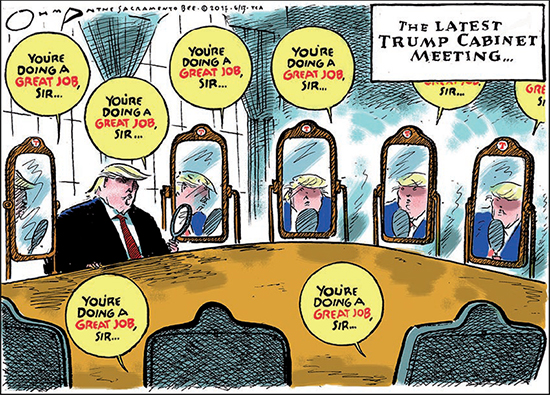
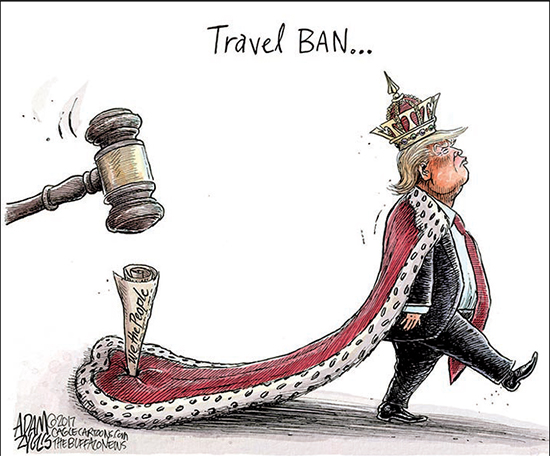
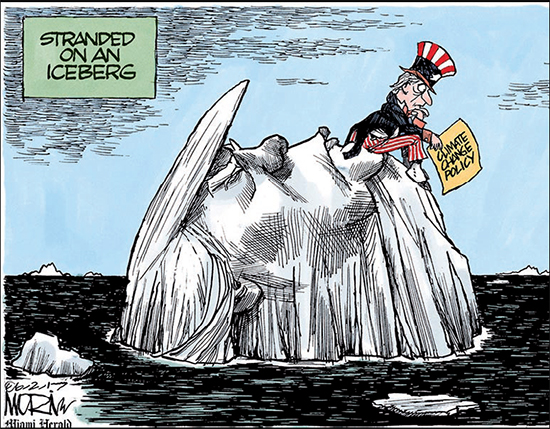
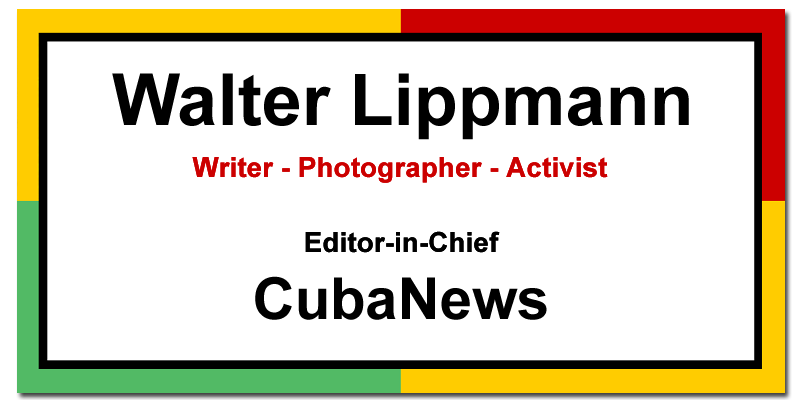

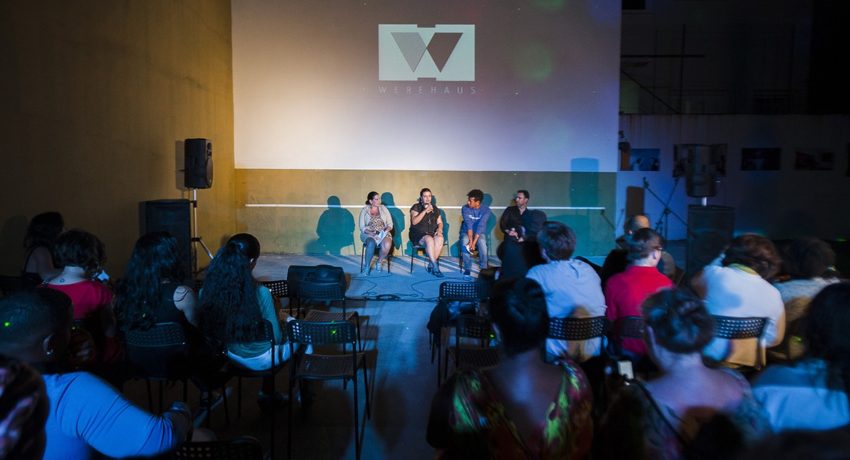
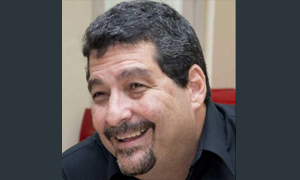
You must be logged in to post a comment.